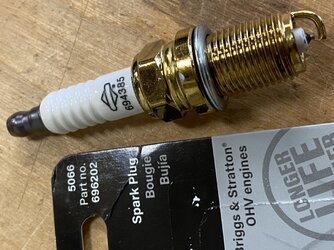Several of you may remember that I hot-rodded my log splitter a few years back, dropping the cycle time from 11-12 seconds down to 8 seconds. This was done by increasing the size of the pump, required line sizes, and replacing the engine with one of nearly double the original displacement.
It's time to replace the spark plug on said engine, and I've run into a surprise. The engine is a Briggs Intek 21R707, and the manual that came with it calls for two spark plug options (for engine type 210000):
Briggs & Stratton 491055 = Champion RC12YC, for regions requiring a resistor type plug
or
Briggs & Stratton 5066 = Champion RC12PYC for those wanting a long-life platinum plug
All are heat range 12, flat seat, all the same dimensions.
However, when I removed the original plug from the engine, I found it marked Champion XC92YC. This plug also has all the same dimensions, but is heat range 92(!). Engine was bought new from Jack's Small Engines, and I don't believe they messed with it, so I'm scratching my head as to what they might've been thinking at Briggs.
At first inspection, the plug seems to be doing well in the engine, not coated over with black carbon as you might expect for a plug that far above the recommended heat range.
I'll continue to dig for an explanation, but given the wide experience and knowledge base of this forum, I'm wondering what the rest of ya'll think about this.
It's time to replace the spark plug on said engine, and I've run into a surprise. The engine is a Briggs Intek 21R707, and the manual that came with it calls for two spark plug options (for engine type 210000):
Briggs & Stratton 491055 = Champion RC12YC, for regions requiring a resistor type plug
or
Briggs & Stratton 5066 = Champion RC12PYC for those wanting a long-life platinum plug
All are heat range 12, flat seat, all the same dimensions.
However, when I removed the original plug from the engine, I found it marked Champion XC92YC. This plug also has all the same dimensions, but is heat range 92(!). Engine was bought new from Jack's Small Engines, and I don't believe they messed with it, so I'm scratching my head as to what they might've been thinking at Briggs.
At first inspection, the plug seems to be doing well in the engine, not coated over with black carbon as you might expect for a plug that far above the recommended heat range.
I'll continue to dig for an explanation, but given the wide experience and knowledge base of this forum, I'm wondering what the rest of ya'll think about this.


